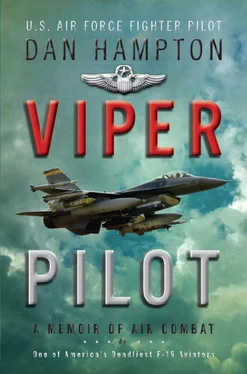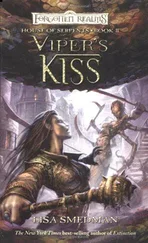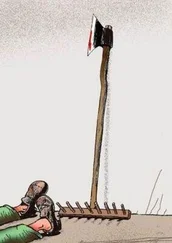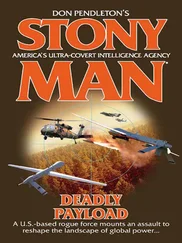You’ve either got it or you don’t.
IT WORKED LIKE THIS.
The first two weeks were spent doing everything but flying: registering with personnel, the flight surgeon, security police, etc. For brand-new lieutenants, this usually meant doing it two or three times to get it right. We also began academics immediately. The USAF is big on technical classroom instruction, and any formal training course, whether you want to become a parajumper or a pilot, has a syllabus. The Air Force requires the highest qualifying scores of the four main service branches just for enlistments, let alone for officers. Given the extreme complexity of modern jets, especially fighters, this is understandable. Since we were recent college graduates, the course load was familiar to us, and we were happy to finally be on the “flight line.”
On any USAF flying base, the flight line consists of the squadrons, maintenance facilities, and everything in between that makes an aircraft go up and down. Located immediately adjacent to the runways and taxiways, this usually remained a pilot’s home until he became a field-grade officer and had to pay homage to gods of paperwork on a staff somewhere. Of course, we weren’t pilots yet. We were “Studs”—short for STUDent pilotS. (Naturally, that was not the explanation we gave girls at the Officer’s Club.) Think of it as a kind of yearlong, performance-based purgatory between being nothing and maybe becoming what you dream.
Then came that first sweet moment when, alone in my BOQ (Bachelor Officer’s Quarters) room, I shrugged into the new, stiff flight suit. It even smelled sweet (that would be the NOMEX material), and with my patches and lieutenant’s bars, I was smokin’.
So I thought.
So did we all.
One problem with that: no wings. This painful fact was pointed out to us at least once per minute by the instructors and any girl who wandered into the O’Club. It was like wearing a nice custom suit with no shoes. Obvious, embarrassing, and the first in a long series of humbling sprays from the Reality Hose. So, like everyone who eventually graduated, I made up my mind to have those prized silver wings, no matter what.
The first half of UPT was conducted in little horrible T-37 jet trainers. It was loud, obnoxious, underpowered, and sat low enough to the ground for the crew chief to look down at the pilot. The Air Force has since switched to T-6 Texans, and they have to be an improvement over the “Tweet,” the T-37. Anyway, the initial phase of pilot training was called “Contact,” and it was the first real chance the instructors had to wash out students. Everything dealing with basic flying was covered here—ground operations, take-offs and landings, spins, aerobatics, and, as always, emergency procedures.
The instructors came from several sources. The best were those who’d had operational assignments and were back in the training command against their will. These were former TTB (tanker, transport, bomber) pilots and, thankfully, a few fighter pilots. Without exception, the fighter guys hated flying trainer aircraft. And why wouldn’t they? Flying in a front-line fighter squadron was as good as it gets in the Air Force, and now to come back to the shiny-boot, scarf-wearing world of the Training Command was a plunge into the abyss. Fortunately for these guys, they only had to do one three-year tour and then it was back to the real world. Thank God all the operational guys were there, though, to muzzle the Others.
The Others were First Assignment Instructor Pilots, shortened to FAIPs, and they were universally a pain in the ass. These were pilots who didn’t get assignments out of the Air Education and Training Command after they graduated from UPT, and they had to stay on as instructors. Sure, they had to go off to San Antonio, Texas, for a few months, where they supposedly learned how to teach students to fly, but the bottom line was this: the only military-aviation experience they had under their belt was UPT and the Texas course. So, you’ve got a guy with less than two years of flying training trying to teach and, most important, evaluate a student’s ability to be an Air Force pilot. In my opinion, some were actually quite good but most were bitter wannabes. This is precisely why the operational pilots were brought back—to keep their thumbs on the FAIPs and give a reality check to the program. Otherwise we’d have an Air Force of close-order drills, sock checks, and spell-checkers.
My primary instructor pilot was a gruff, irreverent former B-52 pilot with the unlikely call sign of “Daddy Rabbit.” There were six of us assigned to him, and we were lucky. Jets are like pets in that the people who fly in them, like pet owners, end up resembling them eventually. The B-52 was known as a Buff (Big Ugly Fat Fucker), and though Daddy Rabbit wasn’t fat, he was big and ugly— and a superb pilot. His gift was instilling the “Big Picture” in his students, i.e., teaching us to not get mired down in minutiae but be aware of all that was going on around us. DR was also calm, unlike FAIPs.
“Punk,” he once said smoothly as I waffled through a spin recovery while Oklahoma filled the windscreen, “ya wanna try and do it right this time so we live to drink at the club tonight.” He also hated the training command and passionately loathed most FAIPs. So, Daddy Rabbit, if you’re reading this, thanks for everything.
Within a week, guys began washing out for air sickness, failure to master emergency procedures, or just a basic inability to think and fly at the same time. If a student busted a ride, he got a repeat, called an “X” ride. If he busted that, then he flew a “Double X” flight with a more experienced, non-FAIP, squadron officer. If he failed again, he went next to a Proficiency Check with a Flight Examiner, and if he didn’t pass it, then he was out. There were students who were fully enrolled and engaged on Monday and gone by Friday.
The Tweet phase progressed through formation flying and basic instrument procedures, and guys continued to drop like proverbial flies. As always, through all of this, there were endless academics. Aerodynamics, aircraft systems, weather, instrument flying procedures—anything that could affect you as a pilot. Emergency training was nonstop. More classroom instruction, simulator flights, and a little ritual each morning called “Stand Up.”
This occurred in the big flight-briefing room. Each instructor pilot had a table and usually four to five students (at the beginning). Every morning, before flying and academics, there was a Mass Brief. This covered weather, the schedule, and general announcements. One instructor would then give a thirty-second scenario involving a flight situation and turn it over to a random student. The Stud would then “Stand Up” and take over, in real time, whatever near-death situation had been presented. With an audience of instructor pilots and his peers, he’d have to take this to a logical conclusion and, hopefully, get the plane back on the ground. It was very effective in teaching a young pilot the basics of thinking on his feet and ignoring outside pressures during a crisis.
AFTER SIX MONTHS AND TWO CHECK-RIDES, THOSE OF US WHO were left got to move across the street to T-38s and the advanced flight phase of UPT. About 40 percent of the initial class was gone by this point, and those remaining were seasoned by now. Not cocky, certainly, because we still didn’t have wings and also had seen too many buddies wash out. But we’d recovered a bit of the misplaced confidence we’d all walked in with.
The attitude was different on the 38 side. Instructors still washed people out, but they figured we’d proven ourselves over the past six months by simply surviving to this phase. The Air Force also had a chunk of money invested in us by this point and would work a bit harder to keep a potential pilot around.
Читать дальше












